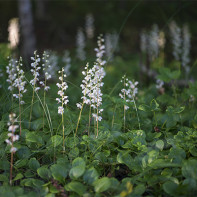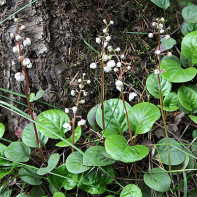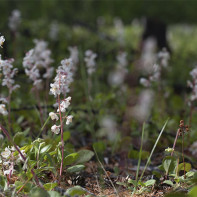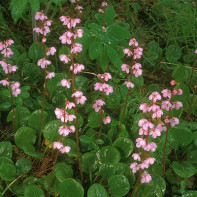Wild pear: medicinal properties and contraindications
Hornberry belongs to a genus of flowering crops of the Vereskova family. The plant has incredibly juicy greens and small inflorescences. The herb has found use in the field of folk medicine and gynecology, helping to cure many diseases. The herbaceous plant also has other names, such as wild frankincense, pearwort, living grass, meadow lily of the valley.
- Chemical composition
- How it looks and where it grows
- Types
- Gathering and storage
- Medicinal properties of pearl millet
- For women
- For men
- Pear extract in folk medicine
- Lung abscess
- Adenoma of the prostate
- Infertility
- Gum inflammation
- High body temperature
- Hepatitis
- Bleeding
- Acute cystitis
- Prostatitis
- Colon cancer
- Colon cancer
- Diabetes mellitus
- Tuberculosis of the throat
- Snake (viper) bite
- Uterine fibroids
- Chronic pyelonephritis
- Epilepsy
- Types of medicinal compositions
- Infusion
- Infusion
- Decoction
- Oil of pearflower: properties and uses
- Contraindications for use
Chemical composition
Perennial medicinal plant is characterized by a diverse chemical composition. Most of the substances contained in pearflower are very valuable in the branch of medicine.
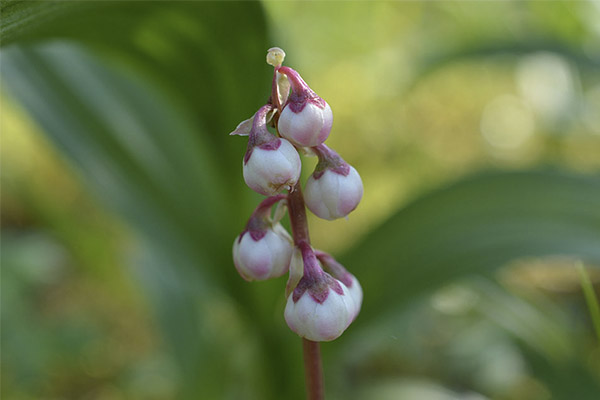
The chemical composition of the herb crop includes the following components:
- aviculirin;
- amirin;
- andromedoxin;
- vitamin C;
- gallic and quinic acids;
- hyperoside;
- tannins;
- gum;
- Minerals (copper, zinc, magnesium);
- saponins;
- sugar;
- mucus;
- resins;
- urson;
- phenols as well as their derivatives (arbutin, isohomoarbutin, methylarbutin, homoarbutin and hydroquinone);
- flavonoids;
- quinones;
- ericoline;
- essential oil.
Note! All of the above components are located both in the above-ground part of the plant, and in the roots. Therefore, in folk medicine for the preparation of medicines are used all parts of the pear tree, namely - flowers and stems with leaves.
How it looks and where it grows
Pearflower is a herbaceous plant with bare, straight stems. It is nourished by a creeping, superficial root system that covers vast areas. The shoots are smooth, light green with brown streaks and reach 40 cm in length.
Leaves are round (can also be ovate and oval), with petioles, fleshy and quite stiff, of a rich green color. The foliage of the pear tree is gathered in a root rosette. The outlines of the central veins can be seen on the front side. Near the base of the stem, there are two long brown leaves.
The crop blooms at the beginning of the summer season, in June. At the top of the stem, small buds begin to blossom into a cluster-like inflorescence. Each flower stalk has 8 dipped corollas, which in some way resemble pear flowers (that's why the plant is called a pear tree). The petals are pink or white. When open look like a five-petal bell. Flowers have a pleasant, delicate scent that resembles that of lily of the valley.
In August comes the fruiting season. Fruits are ball-shaped seed capsules which are slightly flattened on both sides. These capsules contain a large number of small seeds.
Pearberry grows exclusively in the woods near conifers. Quite often the plant can be found near pine trees. The crop can also be seen near deciduous trees. However, the plant rarely gets along with such neighbors.
Note! It is very important for the pear tree that the soil is constantly moist. Only in this case, the plant will grow and develop normally.
Species
In botany, there are about 36 varieties of pearflower. Many of them are found only in the wild. The most well-known species of the plant are:
- Pearflower umbrella. The root system is creeping. Stem reaches a height of 15 cm, closer to the base becomes branched. Leaves are fleshy, oblong, near the petiole narrowed. The upper part of the leaf is dark green, while the lower part is light green. The flowers are pink in color, small in size, and are gathered in an umbrella shape at the top of the stem. Grows in a pine forest in a shady area, the soil must be rich in humus. Its habitat is in Western Siberia and the Far East. For medicinal purposes, it is desirable to use the above-ground part of the culture, which should be collected during flowering pear tree.
- Round-leaved pear tree. The plant is characterized by a branched root system with straight ribbed shoots, the length of which is 30 cm. The leaves are a rich green shade, with a diameter of 6 cm. There is also a petiole, which is 12 cm long. The flowers are colored in white. It is used in both folk medicine and homeopathy.
- Grushanka large-flowered. Is an ornamental species. The stem is small in height, about 12 cm. Shoots upright, brown in color. The leaf plate is a dark green shade. The leaves are quite small. Inflorescences are short but dense, with 8 flowers concentrated in each. Petals are pink, fairly large and fleshy.
- Small pear lily of the valley. Also called lily of the meadow, wild pepper, white birch. The herbaceous crop varies in height from 7-30 cm. The slender stem either has no leaves at all or has a pair of scaly leaves. The root foliage is rounded in shape. Flowers come in different colors: pink, green, light or cream. The lesser pear tree is an ornamental species. Cultivated in forests with conifers. It occurs in Belarus, Central Asia, the Caucasus and the European part of Russia. In folk medicine the stem, leaves and flowers are used as well as the juice of the herb.
- Pear Mountain blossom. Plant is quite tall (can reach 40 cm in height). Leaves are large in size, rounded or ovate. The flowers are scarlet or red-purple. Can be found in Siberia, the Arctic, the Urals and the Far East. Grows in coniferous and mixed forests as well as thickets of cedar trees. For medicinal purposes may use all parts of the perennial herb: stems, flowers and leaves.
- Lopsided pear tree. A medium-sized plant (stem length approximately 25 cm) with a long and branched root system. The leaves are light green, stiff and sharp, ovate, slightly oblong. Small scale-like leaves grow on top of the stem. The flowers are clustered in a lopsided cluster. The flowering period falls in June, ending in July. Cultivated in mixed, coniferous forests and mountains. Very rarely can be found lopsided pear tree in deciduous forests. To prepare medicines can be used as leaves, flowers and stems.
- Pearjacket medium. The herbaceous crop can reach 10-30 cm in length. The rhizome is brown in color, branched, but quite thin, there are adventitious roots in the nodes. In addition, above-ground shoots are formed, at the base of which rosettes of leaves are placed. The latter are fairly leathery, rounded in shape. Floral shoots 10-33 cm long have only one scale-like leaf located either in the center or slightly below. The shoots end in a flower tassel. The corolla is white with a pink tinge near the base. The petals are round, reaching 8 mm in length. Blossoms for 2 months from June to July. Grows only in the coniferous forest area. In alternative medicine, based on the average pear tree make infusions and decoctions. To this end, take all parts of the herb.
- Japanese pear tree. Is an evergreen culture, the height of which is 30 cm. Rhizomes creeping and strongly branching. Leaves are leathery, pointed at the ends, have petioles, closer to the base of pedicel stems are gathered into a rosette. The plant is found only in the Far East in mixed forests.
All species of pearflower differ from each other both in appearance and in the area of distribution.
Important! Despite the fact that virtually all of the above varieties of the plant have medicinal properties, in folk medicine is often used round-leaved pear tree.
Collection and storage
For the procurement of medicinal raw materials, both the leaves and grass of the perennial plant are collected.
Important information! Gather pearl-grass only during the flowering period. At the same time on the street should be dry weather.
The collected leaves are spread on the surface (the layer should not exceed 3 cm). Dry the plant both in a well-ventilated room and outdoors in the shade under a canopy. Once the leaves are well dried, they are placed in paper bags and stored in a dark place. Dried pearl mushrooms has a shelf life of 12 months.
Note! If there is no time to gather the plant, then it can be purchased in the pharmacy in its finished form.
Therapeutic properties of pear grapes
Pear Pear contains a large amount of biologically active components (ascorbic acid, tannins, minerals). Because of this plant has medicinal properties, helps to reduce inflammation, lower body temperature, eliminate cramps, swelling, stop bleeding. It is also characterized by antiseptic and diuretic effect.

In addition, the use of oregano is shown:
- in diseases of the reproductive system;
- purulent wounds;
- Diseases of the muscles, joints and spine;
- scurvy.
Because the plant has a diuretic effect, it helps to remove excess salt from the body, which has a beneficial effect on the condition of patients who have pathologies associated with the musculoskeletal system.
Also oregano reduces blood glucose levels. Therefore, the herb can be used with diabetes.
Flavonoids in the perennial crop help strengthen blood vessels and help capillaries become stronger.
Note! In Chinese folk medicine, the pear tree is used as an antidote, as well as to remove toxic substances from the body when poisoned.
For women.
Perennial herbaceous plant is very useful for the female body, as the pear tree improves the reproductive system and also prevents the risk of cancer.
Experienced experts highlight 5 substances contained in the herb, which have a positive effect on women's health:
- Arbutin. It is an antiseptic that eliminates the inflammatory process in the urogenital system.
- Organic acids, resins. Characterized by anti-inflammatory action, remove pathogenic bacteria from the body, as well as relieve pain and cramps.
- Mucilage and tannins. They fight inflammatory processes, stop bleeding, and remove toxic substances from the body, which have a detrimental effect on health in general.
- Triterpenoids. Lead the fight against viral infections.
- Flavonoids. They have antioxidant properties, activating the body to fight bacteria and viruses. In addition, they eliminate pain and discomfort during the menstrual cycle.
Information! Due to the therapeutic properties, pearl-grass is called a "female herb".
Proponents of folk medicine advise the use of the plant in the treatment of pathologies associated with the genital sphere, namely with weakness and prolapse of the uterus, atony. Often the perennial herb is used in the treatment of fallopian tubes obstruction.
Since the pear tree has a soothing, bactericidal and antiseptic effect, dried herb is used in women's diseases such as gonorrhea, vaginitis, pelvic pain, colpitis, adnexitis.
Also the plant plays an important role in the treatment of infertility, which is associated with an inflammatory process of the genitals.
For men
For men, the benefits of pearflower manifests itself in the treatment of diseases of the genitourinary system, which are infectious or inflammatory in nature.
Note! In the treatment of prostatitis and adenoma of the prostate plant is used only in the initial stage of diseases. If the disease is neglected, the herb can only alleviate the condition of the patient.
The use of the plant in prostatitis makes it possible to:
- Activate the metabolic process (increases regeneration).
- Relieve spasms from muscle tissues and blood vessels (improves urination).
- Strengthen the immune system (prevents the entry into the body of other infections).
Also, the herb crop helps to increase potency, relieve frustration and get rid of depression caused by libido disorder.
To eliminate male illnesses, it is recommended to make infusions, tinctures and decoctions on the basis of pearwort. However, in addition to taking the medicine internally, it is desirable to take baths with a water infusion of the leaves of the plant. Such procedures relieve pain and inflammation, restore the function of the sexual organ, as well as regenerate its tissues.
Hornberry in folk medicine
In the field of alternative medicine, the perennial crop is used to treat women's diseases, eliminate headaches and rheumatic pains, postpartum and hemorrhoidal bleeding, diabetes, hernia, scurvy, as well as bone tuberculosis. In addition, pear pearl millet acts as an antipyretic.
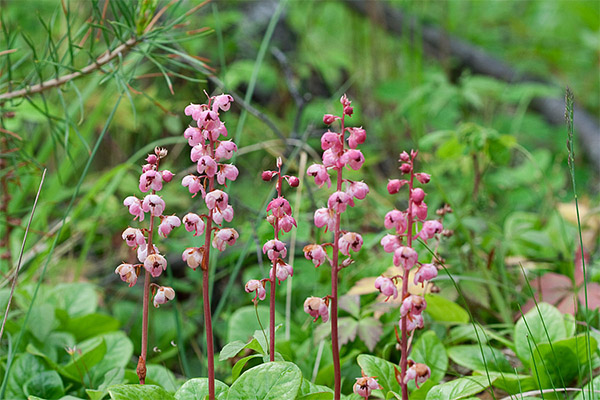
Externally, folk remedies are used to gargle an inflamed throat, strengthen the gums, get rid of unpleasant odor from the mouth, as well as rinse purulent wounds.
Tip! If wounds do not heal for a long period of time, they can be smeared with juice squeezed from fresh grass.
Folk recipes in which pearl-grass is used:
Lung abscess
In a thermos, pour 200 ml of very hot water and pour 1 tbsp. of pearflower. Insist about 60 minutes. Filter the remedy with a piece of gauze. The resulting composition is supplemented with chilled water so that the result is 200 ml. Use 2 tbsp. if there is bleeding. Do not prepare the infusion for the future, because the remedy is stored for only 24 hours.
Adenoma of the prostate
Pour 200 ml of boiling water 1 tbsp dried pearl mushrooms, put the composition on a water bath for a quarter of an hour. Decoction to stand for 45 minutes, and then strain. Add water to the liquid to come out 200 ml. Course of treatment: 1 tbsp. 3 times a day before meals. Use the infusion until the treatment of the disease is over.
Infertility
1 tbsp. herb pour a glass of hot water (not boiling water) and send to a water bath. The remedy to boil for 45 minutes. In this case, the liquid should not boil. After a specified period of time, filter the decoction. Add water to the composition, so that a glass of liquid came out. Drink 1/3 cup 3 times a day before meals. The course of treatment is 3 weeks.
Inflammation of the gums.
Mix 200 ml of boiled water and 2 tsp. grass. A container with the composition to cover and set on a water bath for half an hour. Then infuse for 10 minutes, strain and add water to the original volume. Prepared infusion can be used to rinse the gums, and for oral intake of 100 ml before meals.
High body temperature
Steep 1 tbsp of the plant in boiling water (200 ml) and infuse for 2 hours. Filter the herbal mixture, dilute with water to the same volume. Take 1 tbsp. Three times a day until fever subsides.
Hepatitis
Stir 1 tbsp. plant in a glass of boiling water, cover with something warm and infuse for 2 hours. After that, be sure to filter the composition and add as much water as necessary to return the original volume of infusion. Take the remedy 3 times a day by 1 tbsp.
Bleeding .
To stop hemorrhoids or postpartum bleeding, you will need to stir 1 tbsp of dried herbs in a glass of steep boiling water. Means to wrap a warm cloth and infuse for about a couple of hours. After the allotted time, filter the composition with a gauze cutter, and then refill with cooled water to the same volume. Use three times a day by 20 drops. The treatment lasts until the bleeding stops completely.
Acute cystitis
1 tbsp. pearl mushroom steeped in boiling water (200 ml), put on a water bath and heat for a quarter of an hour. Insist for about 45 minutes. Filter the composition, adding water, so that the original volume came out. Take 1 tbsp. once a day.
Prostatitis .
50 g of the plant pour 500 ml of vodka and take to a darkened place for a couple of weeks. Take 40 drops a quarter of an hour before a meal.
Colon cancer
Steep 1 tbsp. plant in 200 ml of boiling water. Wrap the composition with a warm plaid and infuse for half an hour. Drink 25 drops when bleeding.
Colon cancer.
In boiling water (200 ml) add 1 tbsp. pearl and infuse for 60 minutes. Filter the remedy, add water to return the original volume of liquid. Use 2 tbsp. before meals in the presence of bleeding. The infusion should be stored in a thermos for no more than a day.
Diabetes mellitus.
To steeped boiling water (200 ml) add 1 tbsp. of pearl mushroom, leave in a warm place to infuse for 2 hours. Remove the cake from the remedy, adding water to the original volume. Take 1 tbsp. three times a day regardless of the meal.
Tuberculosis of the throat
1 tbsp. dried herbs steeped in a glass of very hot water and leave to infuse for a couple of hours. Filter the product, add water, bringing the infusion to the same volume. Take 1 tbsp. three times a day.
Snake (viper) bite
1 tbsp. pearl marshmallow steeped 200 ml of boiling water, cover with a warm blanket and infuse for 5 hours. Filter the infusion. The volume of the finished composition will decrease slightly, so you need to add water to restore it. Drink 1 tbsp. for a quarter of an hour before a meal.
Uterine fibroids.
In 1 tbsp of raw materials to pour boiling water (a glass), the container to close and send to a water bath for a quarter of an hour. Infuse for about 45 minutes, strain and add water to the original volume. Take 1 tbsp. once a day if there is bleeding.
Chronic pyelonephritis
In 200 ml of boiling water steep 1 tbsp. The plant and set aside to infuse for a couple of hours. Filter the liquid and bring to the same volume with cold boiled water. Take the medicine three times a day, 1 tbsp. regardless of the meal.
Epilepsy .
Add 1 tbsp. of the plant in a glass of boiled water and send to a water bath. Under a closed lid, the composition is heated for half an hour. After the mixture to infuse for 10 minutes, and then filter. In the finished infusion add so much water that the original volume of liquid came out. Take 2 tablespoons for a quarter of an hour before a meal.
Important! Do not try to self-medicate. Before using a medication based on pearljacket, it is necessary to consult with the attending physician. Only a doctor has the right to prescribe the reception of herbal composition for a particular disease.
Types of medicinal compositions
In addition to treating specific diseases, water infusions, tinctures and decoctions are made on the basis of pearflower. Such universal remedies are preventive in nature and provide an opportunity to cure diseases of the urogenital system, to remove swelling, dropsy, relieve inflammation of the joints, improve appetite and normalize the activity of the gastrointestinal tract.
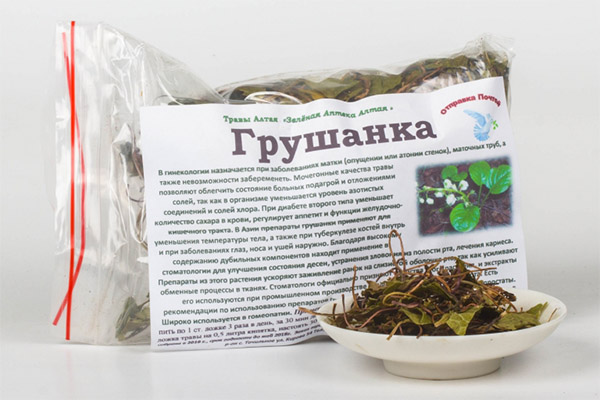
Infusion .
To prepare a water infusion will require a mixture of dried leaves and flowers of the plant, as well as water. The remedy should be consumed by 1/3 cup three times a day.
To make the composition, you need to do the following:
- 2 tsp. herbs add to a glass with boiling water.
- Set the remedy on a water bath and heat for 15 minutes.
- After the specified time, insist for 60 minutes. After the infusion, filter it.
Note! If there is no dried herb at hand, then you can take fresh leaves and flowers of the plant.
Tincture .
To make an alcoholic tincture based on pearl-grass, you need to use only dried flowers and leaves of the grass.
The way of preparing a therapeutic tincture:
- 50 g of the plant put in a jar, adding 500 ml of vodka.
- The resulting composition is thoroughly shaken and sealed with a lid.
- Insist the mixture for 14 days in a dark place. Every 3 days shake the liquid.
- After 14 days, filter the tincture.
The composition to take 30 drops for about 20 minutes before eating.
Tip! If the tincture is very strong and bitter to the taste, it can be diluted in a small volume of water.
Decoction
To make a decoction, either the roots or grains of the herbaceous plant are used.
To make a medication based on pearwort, you will need:
- 15 g of the product to steep 180 ml of steep boiling water.
- Send the herbal liquid to a water bath. Heat over low heat for about half an hour.
- After that, set the remedy aside for a quarter of an hour, and then separate the cake from the infusion by straining.
Take the decoction by 2 tbsp. 4 times a day after meals.
Oil of pearflower: properties and application
Oil of pearflower is made from the leaves and young shoots of the herbaceous culture. The components included in the preparation, easily penetrate deep into the skin.
Oil of pearflower has properties such as:
- diuretic;
- diuretic;
- vasodilator;
- analgesic;
- anti-inflammatory;
- antiseptic.
In addition, the drug is refreshing, toning and uplifting.
Application of oil of pearflower:
- Pain relief. Relieves pain in joints and bones, muscle cramps, headache. Relieves tension and stress.
- Relief from arthritis and rheumatism. Participates in the stimulation of blood movement near the affected muscles and tissues, and helps clear the blood of obstruction. Improves urination by removing toxins and uric acid from the body.
- Prevention of infection. It protects the body from fungal diseases and Staphylococcus aureus. However, you should not drink the oil.
- Improves the condition of the facial skin and hair. Eliminates boils, pus wounds, blackheads and pimples on the face. However, for these purposes, the oil must be used in diluted form. In addition, the remedy gets rid of dandruff and activates hair roots, thus stopping hair loss.
Note! The essential oil of the plant should only be used for massage. It is not designed for internal use.
Also, the composition has contraindications - individual intolerance and sensitive skin.
To check if you are allergic to this product, you should apply a small amount of oil on your elbow bend. If 48 hours later the skin showed no redness or rash, it means that the product is safe.
The oil should be stored in a cool dry place.
Contraindications for use
Taking medications based on pearl millet is not dangerous for the human body. However, if you abuse the drugs, you can cause enormous damage to health.
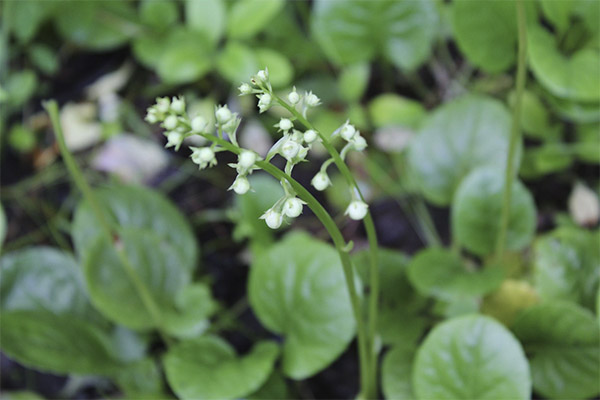
The plant is contraindicated for use:
- for anemia;
- pregnancy;
- varicose veins;
- A high level of hemoglobin in the blood;
- breastfeeding;
- Individual intolerance;
- low blood pressure;
- high blood clotting;
- thrombophlebitis.
Important! It is also not recommended to give the pear tree young children.
With excessive use of medicines made on the basis of the herb, the following side effects may occur:
- blood in the urine;
- a feeling of intoxication;
- poor coordination;
- confusion.
If such symptoms occur, you should immediately refuse to use the pear tree. In this case, be sure to consult a doctor, so that the doctor can prescribe another treatment.
The perennial herbaceous crop is very useful for the normal functioning of the human body. It contains a huge amount of substances that help to get rid of various kinds of diseases, as well as maintain health in general. The plant is used to make decoctions, alcoholic tinctures and water infusions. However, pearwort will give a positive effect, if you do not abuse preparations on the basis of the plant.
«Important: All information on the site is provided solely for introductory purposes. Before applying any recommendations consult with the profile specialist before using any of the recommendations. Neither the editors nor the authors shall be liable for any possible harm caused by materials."


